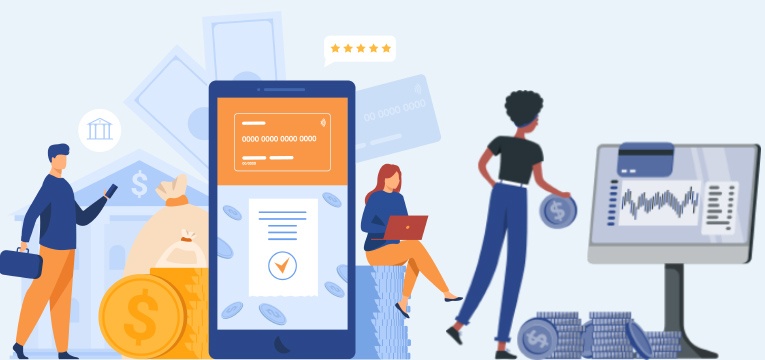Real-Time Payments: Everything You Need to Know
As we move towards a technologically advanced era, there is a mass adoption seen in developing competent apps. Specifically, in the finance sector, there are apps that are all set to make a difference. There are a variety of apps available in the finance market that are dedicated to resolving singular challenges such as cost-saving apps, investment apps, P2P apps, cryptocurrency apps, crowd-funding apps, regular tech apps, real-time payment apps and so on. The list is endless.
Real-time payment systems are one of the most popular choices among finance businesses and most of them are constantly making an effort to bring it for their business.
In this blog, we are going to dig deeper into real-time payments applications and try to understand how these apps are developed, what difference they make within business, the challenges faced during its development and finally the benefits. So, let’s get started.
1. What are Real-Time Payments?
Real-time payment can be defined as an instantaneous or rapid way of money processing. This enables both the parties to perform real-time transfer between accounts through digital payment methods. The very obvious attribute in Real time payment is derived from the name: they operate in real time, or very close to it, initiating, clearing, settling and instant confirmation in a matter of seconds.
While there is a myth that all the real time payments just process requests faster and in real time but it does not mean they are real-time payments. There are many problems solved by real-time payments. A more efficient payment journey can only be achieved by bilateral communication via integrated information flows, quick payment confirmation notifications, and settlement. Financial control, cash positioning, and liquidity management are now possible points that are addressed by real-time payments.Real time payments are non refundable which means if it is processed once, it cannot be reversed.
2. The Reality of Real-Time Payments
If we shift our clocks to a few years ago, we would have a sense of realization of how challenging it was to transfer money through electronic transfer. It would minimally take two to three days for a smaller transfer. But now with the discovery of real time payment everything is at fingertips.In comparison to some historical payment methods, which might take days to reach a recipient, real-time payments provide a faster, more consistent way of payment. Now the expectation with real time payment is to be real-time and not just fast.
The real scenario differs from country to country. Many other countries only have a few financial institutions serving their citizens, whereas countries like the United States have thousands of active financial institutions. Consumers, corporations, and world governments will all be affected socially and economically by this newer, more seamless means of doing financial transactions.
Furthermore, rather than requiring change through regulatory demand, the market has depended on the private sector to faster innovation. While the industry as a whole acknowledges that efficient real time r payments provide a number of cash-flow benefits, financial institutions, technology suppliers, and anybody else participating in the discussion have expressed major disagreements on how to achieve this aim.
There are a few sets of statistics which effectively showcase the reality of real-time payment.
- Reports from ACI Worldwide, 9.8% of global electronic transactions were completed in real time by 2020.
- India had the greatest real-time transaction value of $25.5 billion, followed by China at $15.7 billion and South Korea at $6 billion. There is Thailand who ranks first in real-time payments, ahead of Nigeria, which is ranked sixth.
- As we have seen a boost in the adoption of smartphones after the toll of pandemic and market expansion. In June 2021, we saw a global rise in adoption of digitization.
- Real-time payments are expected to become increasingly important in the retail and e-commerce industries, owing to the current Covid-19 pandemic, which has driven people to switch to online shopping.
- After COVID-19 pandemic took place, there is an acceleration of the shift to digital payments, global real-time payments(RTP) transactions will increase by 41% in 2020, according to new ACI Worldwide research.
3. Where Can You Get Real-Time Payments?
The answer to where to find a real-time payment is quite simple. We find it everywhere. Nowadays, a real-time payment(RTP) network is the new kryptonite. You’re more likely to see real-time payments almost in all transactions. These apps allow users to send and receive money virtually instantly, any day of the week and at any time of day-though instant, payments may incur a fee in addition to ordinary payments, which are free(not always). There is no need to exchange cash or a check. Instant payment already means you don’t have to go to a bank branch or wait for the money to deposit during business hours.
4. How to Use Real-Time Faster Payments Wisely
Real-time payments offer lightning speed for all types of services and transactions. This is one of the most obvious reasons why it is preferred by most of the industries and verticals. Always look for quick solutions. If speed is important, you must go for it. You may have more options than you realize, but choose a faster one and that is only offered by a real time payment platform. It can be anything whether it is a quick-closing mortgage or real-time payment capabilities for your small business. You can also inquire with your bank about how they can assist you to shop elsewhere where there is an RTF facility which will speed up your requirements.
Fast cash may be more expensive, but be wary of unreasonable fees or decisions that aren’t in your best interests. If you want a personal loan with quick funding, you might be willing to spend a little extra in interest or fees.
5. The Challenges of RTP For Financial Institutions
Wth obvious reasons, there were challenges first and then ways were invented to overcome those challenges. So before we discuss the benefits of real-time payments, we must address the challenges that are widely acknowledged. Standardization, interoperability and risk management are required by all financial institutions and infrastructures, and with RTP, these things are made easier. RTP is cost-effective, and has a flexible interface that fully supports technology to use and re-use.
Banks are being compelled to rethink their business models as Payments Market Infrastructures (PMIs). You can convert them to enable real-time payments. They must cope with duties to offer round-the-clock payments to their domestic consumers, as well as handling different payment schemes around the world and eliminating the perils of fraud.
Building a good real-time capacity is difficult enough, but legacy infrastructures and current system or operational constraints make it even more difficult.
6. Real-Time Payment Benefits
When this method of payment was introduced, it wasn’t considered a good option. Businesses were reluctant to use this because of the fear of losing the amount instantly. But sooner the businesses gained trust, this method turned out to be extremely popular. Real-time Payment offers instant, round the clock and secure way of electronic fund transfer that can be done with smart phones and smart phone apps.. You can use smartphones, tablets, and digital wallets using internet services.
RTP’s potential resides in its broad applicability and expanded capabilities, which are currently being determined. Here are some of the primary advantages mentioned by early RTP adopters:
- Increasing revenue through increasing consumer spending
- Consumers benefit from lower payment prices and higher-value offerings.
- New customer segments are being enticed to participate.
- The perils of fraud being reduced
- Long-term consumer engagement and customer ties are being improved.
- To stay competitive, you must be able to develop new-edge new product offerings.
- Businesses can also benefit from real-time payments by improving cash flow and, as a result, operational efficiencies, budgeting, and overall cash management.
7. Conclusion
In the end, what a consumer wants is a faster and efficient way of payment. Real Time payment applications show ripple benefits and are open to cater to almost all types of businesses and industries. It is capable of offering speed, integration, security to consumers and all businesses.If you are a business looking to develop a real-time payment application then look no further than third-party companies who are experts in developing and integrating such platforms with your line of business. This will enhance your overall productivity, boost sales and improve customer’s satisfaction.

Hardik Dhanani has a strong technical proficiency and domain expertise which comes by managing multiple development projects of clients from different demographics. Hardik helps clients gain added-advantage over compliance and technological trends. He is one of the core members of the technical analysis team.
Over these years React js and React Native have been pretty much in vogue, especially since these are some of the leading front-end frameworks. After...
 Apr 7, 2022
Apr 7, 2022 



Comments
Leave a message...